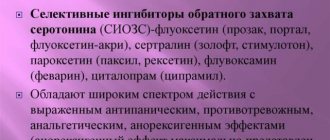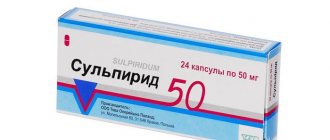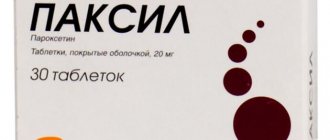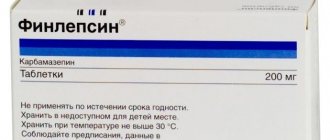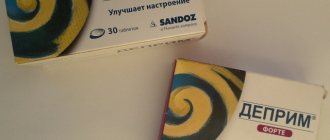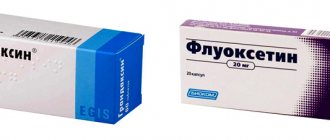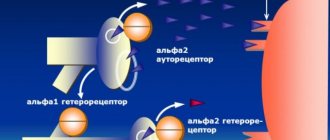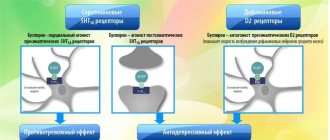Compound
Zopiclone capsules, milky in color with a creamy tint, are packaged in contour cells of ten pieces. There are two blisters in total in the package.
One tablet contains one active ingredient - zopiclone. Additional microelements are the following components:
- lactose monohydrate;
- magnesium stearate;
- hypromellose;
- titanium dioxide;
- potato starch;
- calcium dihydrogen phosphate.
Instructions for use
Zopiclone is taken orally once shortly before bedtime. The recommended daily dose for an adult patient is seven and a half milligrams.
In the presence of severe or persistent insomnia, the dosage can be doubled. For elderly people, it is recommended to start treatment with a small dose - 3.75 milligrams (half a tablet); if there is no result and adverse reactions occur, it can be increased.
Patients with impaired renal function do not need to adjust the dosage regimen. In case of severe liver failure, the drug should be consumed no more than 3.75 milligrams per day.
Pharmacological properties
Pharmacodynamics.
Zopiclone belongs to the cyclopyrolone group and is similar to the pharmaceutical class of benzodiazepines. The pharmacodynamic effects of zopiclone are qualitatively similar to those of other compounds of this class: muscle relaxant, anxiolytic, sedative and hypnotic agent, anticonvulsant, amnestic (causes memory impairment).
These effects are due to the fact that it acts as a specific agonist of receptors that belong to the macromolecular GABA-omega receptor complex in the central nervous system (which are called BZ1 and BZ2 and modulate the opening of chloride ion channels).
In humans, zopiclone has been found to increase sleep duration, improve sleep quality, and reduce the frequency of nighttime and early awakenings.
This effect is due to characteristic electroencephalographic characteristics that differ from those inherent in the action of benzodiazepines. Polysomnographic studies show that zopiclone reduces stage I and increases stage II sleep, maintains or prolongs stages of deep sleep (III and IV), and maintains the stage of paradoxical or rapid eye movement (REM) sleep.
Pharmacokinetics.
Absorption. Zopiclone is rapidly absorbed: peak plasma concentrations are reached after 1.5-2 hours and are 30, 60 and 115 ng/ml after administration of 3.75 mg, 7.5 mg and 15 mg, respectively. Bioavailability is approximately 80%.
Absorption is not affected by time of use, repeated use or gender of the patient.
Distribution. Zopiclone is very quickly distributed from the vascular bed. Plasma protein binding is low (about 45%); binding is saturated. The risk of drug interactions due to substitution at the protein binding site is very low.
The decrease in plasma concentrations in the dose range from 3.75 mg to 15 mg does not depend on the dose.
The half-life is approximately 5 hours.
Benzodiazepines and related compounds cross the blood-brain barrier and placenta and are excreted into maternal breast milk. During breastfeeding, the pharmacokinetic profiles of zopiclone in maternal milk and plasma are similar. The estimated percentage of dose consumed by the infant does not exceed 0.2% of the dose received by the mother in 24 hours.
Metabolism. Zopiclone is extensively metabolized in the liver. The two main metabolites are the N-oxide (pharmacologically active in animals) and the N-demethylated derivative (pharmacologically inactive in animals). Their apparent half-lives, determined from urinary excretion studies, are approximately 4.5 and 7.5 hours, respectively.
This is consistent with the fact that after repeated doses (15 mg) for 14 days there is no significant accumulation. During the studies, there was no increase in enzymatic activity in animals, even when administered in high doses. Excretion. The low renal clearance of unchanged zopiclone (mean 8.4 ml/min) compared with plasma clearance (232 ml/min) suggests that zopiclone is excreted primarily as metabolites. Approximately 80% of the substance is excreted by the kidneys in the form of free metabolites (N-oxide and N-demethylated derivative), and about 16% is excreted in feces.
Groups of patients at particular risk.
Elderly patients: Although hepatic metabolism is slightly reduced and the mean elimination half-life is 7 hours, zopiclone has not been shown to accumulate in plasma following repeated dosing in multiple studies.
Patients with renal failure: with long-term use of the drug, there was no accumulation of zopiclone and its metabolites. Zopiclone penetrates dialysis membranes. When treating overdose, hemodialysis is not appropriate because zopiclone has a large volume of distribution.
Patients with liver cirrhosis: Plasma clearance of zopiclone is significantly reduced due to delayed demethylation, so dosage adjustment is necessary for these patients.
Clinical characteristics.
Peculiarities
During the treatment period, it is not recommended to consume alcoholic beverages and psychotropic medications. Immediate termination of the course does not provoke withdrawal syndrome.
When using Zopiclone for myasthenia gravis, due to a possible increase in muscle weakness, it is necessary to establish certain control over the patient's condition.
The duration of therapy should not be more than one month. Due to the risk of dizziness and impaired coordination of movement, the next day after taking the tablet, driving a car and performing other dangerous work must be done with extreme caution.
Contraindications
The drug Zopiclone has contraindications:
- hypersensitivity;
- decompensated respiratory failure;
- pregnancy;
- lactation period;
- up to 15 years.
Carefully:
- severe liver and kidney failure;
- those suffering from sleep apnea;
- with myasthenia;
- simultaneous use with drugs that depress the central nervous system.
Generics
According to the instructions and reviews, a number of the following drugs are analogues of Zopiclone (synonym), for example:
- "Imovan."
- "Relaxon".
- "Thorson"
- Zolinox.
- "Somnol."
- "Piclodorm."
Terms and conditions of storage: store in a dark place inaccessible to children. Shelf life - twenty-four months. The tablets are dispensed from the pharmacy strictly according to the prescription.
Analogues of Zopiclone
Level 4 ATX code matches:
Sonnat
Relaxon
Ivadal
Sanval
Zolpidem
Somnol
Andante
Imovan
Among Zopiclone analogues, the following drugs can be distinguished:
- Imovan;
- Relaxon;
- Zopiclone SL;
- Somnol;
- Piclodorm;
- Thorson.
"Imovan"
The active microelement is zopiclone, a hypnotic substance of the cyclopyrrolon group. The drug has a sedative, tranquilizing and muscle relaxant effect.
When using Imovan, it is important to remember that, despite the insignificant probability, there is a risk of addiction to the active substance and abuse of it.
The likelihood of addiction appears when dosages are violated and treatment is too long.
The risk of withdrawal syndrome and rebound insomnia after stopping the course should not be ruled out, especially after long-term use of Imovan. As a result, the dosage of the drug must be reduced gradually.
Side effects
With the correct dosage of the drug, there are usually no side effects of Zopiclone. However, if the dosage is significantly exceeded, the following ailments may occur:
- amnesia;
- behavioral disorders;
- aggressiveness;
- somnambulism;
- confusion or changes in consciousness;
- rebound insomnia;
- psychological or physiological dependence;
- speech disorders;
- depression;
- lack of coordination;
- dizziness;
- ataxia;
- hallucinations;
- euphoria;
- headache;
- decreased sex drive;
- skin rashes;
- diplopia;
- hypotension;
- angioedema;
- urticaria and other manifestations of allergies;
- asthenia;
- hypotension;
- vomit;
- anorexia;
- diarrhea;
- weight loss.
It is worth noting that in case of an overdose, patients experience dry mouth and a bitter taste. In some cases, the activity of liver enzymes may increase.
"Relakson"
A medicine that is used for chronic insomnia of various origins.
During night attacks of bronchial asthma in people who receive methylxanthine drugs, Relaxon weakens asthma attacks in the early hours and reduces their duration.
After completing a course of therapy, especially a long one, there is a risk of rebound insomnia and drug withdrawal syndrome, so it is not recommended to discontinue Relaxon quickly; it is important to gradually reduce the dose.
During therapy, you need to avoid alcoholic beverages, as they enhance the sedative effect.
"Zolinox"
The medication is indicated for use in the presence of the following sleep disorders:
- difficulty falling asleep;
- night awakenings;
- early awakening;
- insomnia.
When using Zolinox, sleep occurs within thirty minutes and lasts six to eight hours. Eliminates headaches. Eliminates asthma attacks in the morning, reduces their intensity and duration.
Long-term use is not recommended; the course of therapy should not exceed twenty-eight days. The next day after using the medicine, patients should drive with caution and work with complex mechanisms.
"Somnol"
The drug is, according to reviews, an analogue of Zopiclone. A photo of the drug is presented above. The medication is available in the form of tablets for oral administration. The capsules are film-coated, biconvex round in shape, milky in color, with a line on one side of the surface.
"Somnol" is recommended for use by adult patients to eliminate situational and transient insomnia, including difficulty going to bed, as well as night awakenings.
The tablets are intended to be taken orally in the evening, usually before bedtime. It is recommended to use the drug for no longer than four weeks, including periods of dose reduction.
The decision to increase the dose and extend the course beyond the prescribed period is made only by doctors. Therapy begins with a minimum dosage. It is contraindicated to use the medicine in doses that exceed the maximum.
Overdose
An overdose of the drug occurs when the recommended average therapeutic doses of the drug are exceeded and can threaten the patient’s life. As a rule, in case of overdose, depression of the central nervous system occurs. Signs of overdose include a lethargic state of the patient, as well as drowsiness , confusion , respiratory depression, ataxia , hypotension and hypotension .
If no more than an hour has passed since taking the drug, you can induce vomiting in the patient. In other cases, gastric lavage should be performed immediately, paying special attention to respiratory protection. In order to reduce the absorption of zopiclone contained in the drug, patients are prescribed activated charcoal .
"Piklodorm"
It is an analogue of Zopiclone. The drug has a hypnotic and sedative effect. Instantly and completely absorbed in the gastrointestinal tract. The maximum content is reached one to three hours after taking the medicine. It quite easily passes through physiological filters and spreads throughout organs and systems, including the brain. Reduces bedtime, does not change the phase structure of dreams, and enhances sleep cycles.
Does not provoke unnecessary symptoms after insomnia. No feeling of sleepiness the next morning. Reduces the number of night awakenings.
Falling asleep occurs within thirty minutes, sleep continues for eight hours. Eliminates headaches. In people with nocturnal manifestations of bronchial asthma, when used together with theophylline, asthma attacks occur less frequently in the early hours. The medicine weakens their intensity and duration.


